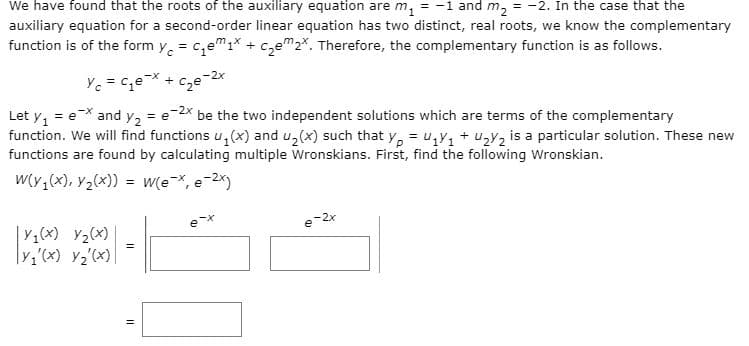We have found that the roots of the auxiliary equation are m, = -1 and m, = -2. In the case that the auxiliary equation for a second-order linear equation has two distinct, real roots, we know the complementary function is of the form y, = c,em1* + c,em2*. Therefore, the complementary function is as follows. Yc = Ce* + cze-2x Let y, = eX and y, = e-2X be the two independent solutions which are terms of the complementary function. We will find functions u, (x) and u,(x) such that y, = u,y, + u,y, is a particular solution. These new functions are found by calculating multiple Wronskians. First, find the following Wronskian. W(y;(x), Y2(x)) = w(e-X, e-2x) %3D e-2x |Y1(x) Y2(x) |y,'(x) Y2'(x)
We have found that the roots of the auxiliary equation are m, = -1 and m, = -2. In the case that the auxiliary equation for a second-order linear equation has two distinct, real roots, we know the complementary function is of the form y, = c,em1* + c,em2*. Therefore, the complementary function is as follows. Yc = Ce* + cze-2x Let y, = eX and y, = e-2X be the two independent solutions which are terms of the complementary function. We will find functions u, (x) and u,(x) such that y, = u,y, + u,y, is a particular solution. These new functions are found by calculating multiple Wronskians. First, find the following Wronskian. W(y;(x), Y2(x)) = w(e-X, e-2x) %3D e-2x |Y1(x) Y2(x) |y,'(x) Y2'(x)
Algebra & Trigonometry with Analytic Geometry
13th Edition
ISBN:9781133382119
Author:Swokowski
Publisher:Swokowski
Chapter3: Functions And Graphs
Section3.3: Lines
Problem 22E
Related questions
Question

Transcribed Image Text:We have found that the roots of the auxiliary equation are m, = -1 and m, = -2. In the case that the
auxiliary equation for a second-order linear equation has two distinct, real roots, we know the complementary
function is of the form y. = c,em1* + c,em2*. Therefore, the complementary function is as follows.
Yc = Ce* + cze-2x
Let y, = e* and y, = e-2x be the two independent solutions which are terms of the complementary
function. We will find functions u,(x) and u,(x) such that y, = u,y, + uzy, is a particular solution. These new
functions are found by calculating multiple Wronskians. First, find the following Wronskian.
W(y;(x), Y2(x)) = W(e-X, e-2x)
%3D
e-2x
|Y1(x) ¥2(x)
|y,'(x) Y2'(x)
Expert Solution
This question has been solved!
Explore an expertly crafted, step-by-step solution for a thorough understanding of key concepts.
Step by step
Solved in 2 steps with 1 images

Recommended textbooks for you

Algebra & Trigonometry with Analytic Geometry
Algebra
ISBN:
9781133382119
Author:
Swokowski
Publisher:
Cengage


Elementary Linear Algebra (MindTap Course List)
Algebra
ISBN:
9781305658004
Author:
Ron Larson
Publisher:
Cengage Learning

Algebra & Trigonometry with Analytic Geometry
Algebra
ISBN:
9781133382119
Author:
Swokowski
Publisher:
Cengage


Elementary Linear Algebra (MindTap Course List)
Algebra
ISBN:
9781305658004
Author:
Ron Larson
Publisher:
Cengage Learning

Linear Algebra: A Modern Introduction
Algebra
ISBN:
9781285463247
Author:
David Poole
Publisher:
Cengage Learning

Algebra: Structure And Method, Book 1
Algebra
ISBN:
9780395977224
Author:
Richard G. Brown, Mary P. Dolciani, Robert H. Sorgenfrey, William L. Cole
Publisher:
McDougal Littell